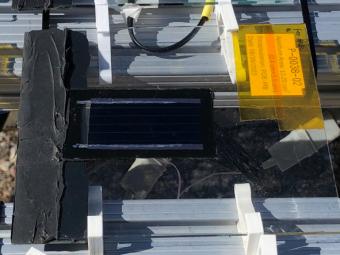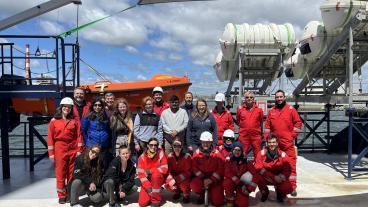Mines-developed molecule improves performance of perovskite solar cells
Called EtCz3EPA, the molecule was designed, synthesized by research group of Alan Sellinger, professor of chemistry and material science

A new molecule discovered by Colorado School of Mines researchers has been shown to improve performance of perovskite solar cells under natural conditions.
The findings, recently published in the journal Science, address one of the key durability challenges of the advanced solar cells, known for their high potential for significant power conversion efficiencies: While perovskites show great potential in lab tests under LED lights, the UV radiation contained within actual sunlight can weaken some of the chemical bonds within the cells, leading to faster degradation and reduced efficiency.

To tackle this issue, the research group of Alan Sellinger, professor of chemistry and material science at Colorado School of Mines, designed and synthesized a molecule called EtCz3EPA, which forms stronger bonds within the solar cells, enhancing the connection between different parts of the cells. In doing so, the molecule increases the cell’s stability and efficiency – even when exposed to UV radiation and tested outdoors.
“This research is a true collaboration between organic synthetic chemists and solar cell device engineers working together to solve big problems,” Sellinger said. “Furthermore, the chemistry to prepare the molecule of interest in this study is relatively simple and just the tip of the iceberg.”
Collaborators included researchers from University of North Carolina-Chapel Hill, National Renewable Energy Laboratory, University of Toledo, University of California, San Diego, and Mines.
“The modules, installed in September 2023 and reported in this study, are the first tested in the Perovskite PV Accelerator for Commercializing Technologies (PACT) Center to demonstrate a greater than 16 percent efficiency after 35 weeks of outdoor testing and remain operational in the field,” said Laura Schelhas, deputy director of PACT and manager of the Hybrid and Nanoscale Materials Chemistry Group at NREL. “There is still work to be done as modules need to perform for years in the field; however, this is an encouraging step in the development of these materials.”
Researchers are exploring various approaches to mitigate UV damage, such as combining EtCz3EPA with PTAA, or poly[bis(4-phenyl)-(2,4,6-trimethylphenyl)-amine], a type of organic polymer commonly used in electronic applications including solar cells, in a hybrid structure, which showed remarkable stability and performance. Devices with a combination of EtCz3EPA and PTAA exhibited nine-times-slower degradation rate.
Hole transport materials (HTMs), which are substances used in solar cells and other electronic devices to facilitate the movement of positively charged carriers, known as “holes,” are critical components for helping to improve the efficiency, stability and longevity of perovskite solar modules, said Jinsong Huang, Louis D. Rubin Jr. Distinguished Professor in UNC-Chapel Hill’s Department of Applied Physical Sciences. The movement of these holes, along with electrons, is vital for electrical conduction in devices like solar cells.
“Hybrid hole transport material devices are particularly important for advancing the commercialization of perovskite solar cells,” Huang said. “By addressing the stability and performance challenges of perovskite solar cells, hybrid HTM structures enable the development of more reliable and efficient solar technologies suitable for real-world applications, including large-scale solar power generation.”
Read the full study, “Strong-Bonding Hole-Transport Layers Reduce Ultraviolet Degradation of Perovskite Solar Cells, at https://www.science.org/doi/10.1126/science.adi4531.




